STANDARD BEHIND YOUR WALLS
The one thing you can not go back and remodel or upgrade later is what is behind your walls. Here we will SHOW you what we do and in some cases let you know what most builders get by with. Wardcraft’s high performance standards form the foundation of a superior energy-efficient home that exceeds even the most stringent regional building codes. Quality construction helps homeowners live comfortably while paying lower monthly energy bills. Our product choices were carefully selected for durability, low maintenance, optimum value and performance. Our standards include:
Enhanced Insulation Package, Formaldehyde-Free
BENEFIT: Properly installed, high R-value insulation requires less energy to heat and cool, resulting in lower utility bills and a quieter, more comfortable home.
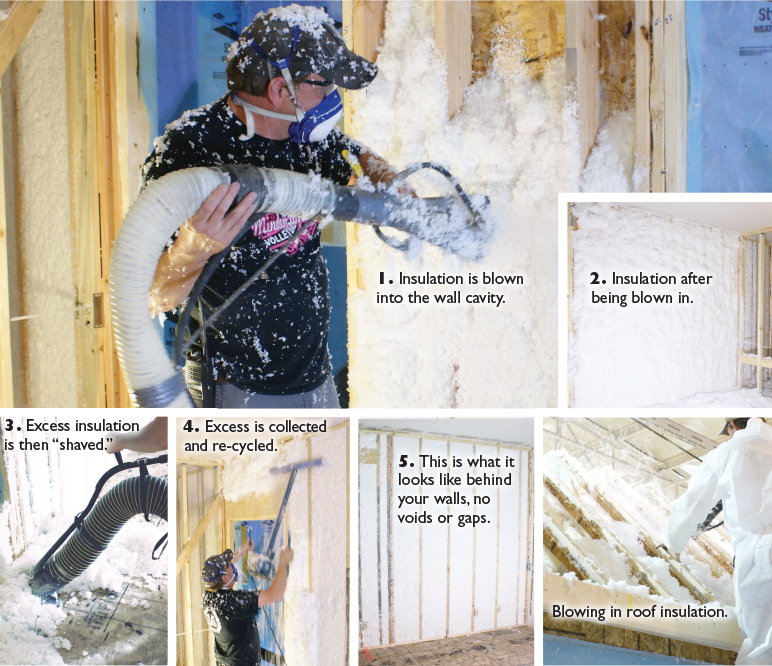
Standard 2″ x 6″ R-23 Exterior Walls
Johns Manville Spider® Plus blown-in insulation, features interlocking fiber technology. This allows the fibers to spring and lock into cavities with no adhesive or netting. This product far outperforms fiberglass batt insulation and other blown insulation systems that introduce water into the building envelope and tend to settle over time. With Johns Manville Spider® Plus there is a much tighter installation that eliminates settling, gaps, voids and depressions forming an interlocking shield against the elements. This improves energy efficiency as well as decreasing sound transmission. The insulation is treated with an EPA registered mold inhibitor to protect against mold. In addition, only fiberglass insulation made without formaldehyde—such as Spider Fiber Plus —can pass Environmental Specification 1350, the toughest indoor air quality test in North America, with no formaldehyde detected. During factory tours, we invite visitors to touch this unique product, which feels like cotton.

Standard R-49 Attic Insulation
Johns Manville Climate Pro® formaldehyde-free blown-in loose-fill fiberglass is a premium alternative to fiberglass batt and cellulose insulation. Be assured that your home is highly energy efficient with minimal heat loss. Unlike cellulose, it won’t decay or provide food for animals or microbes. Effective for the life of your home.

Optional Ultra Insulation R-28 walls/R-49 Attic or Optional Arctic Insulation R-32 walls/R-60 Attic
Exceed the harshest climate zone requirements in America with our standard R-23+ optional R-5 continuous rigid foam insulation for R-28 walls OR our standard R-23+ optional 9.3 continuous rigid foam insulation for a total wall R-value greater than R-32. Johns Manville AP™ Foil-Faced Foam Sheathing provides a continuous layer of insulation, reducing thermal bridging through wood studs, saving energy and improving comfort. Additional depth Johns Manville™ Climate Pro insulation raises the home’s attic insulation to R-60. A specialized energy truss with raised heel height at the eave allows for higher depth insulation in the hard-to-reach outside edges of a truss where most R-values are restricted by the depth of the cavity itself.
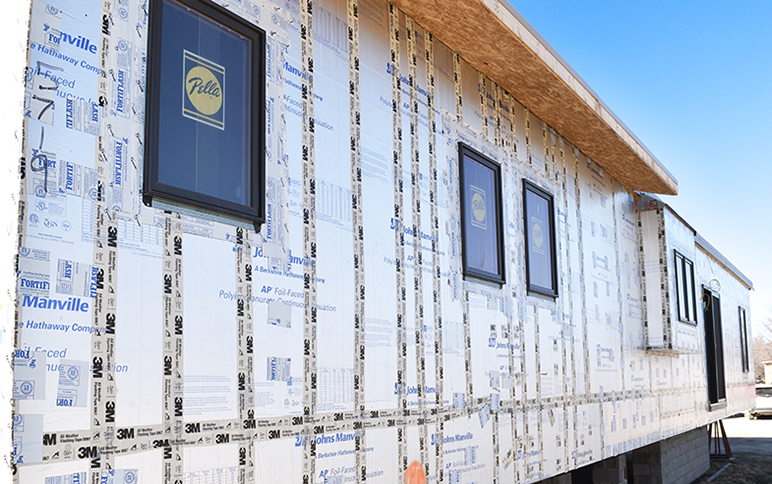
Tight Building Envelope & Air-Sealing Techniques
BENEFIT: High quality construction practices and air-sealing techniques reduce energy loss by keeping the heated or cooled air inside the home.
Standard Advanced Sealing Techniques.
1 We caulk all exterior sheathing seams.
2 Tape all house wrap seams and seal the bottom plate of the wall to the subfloor.
3 Our Full Box Construction® joins the walls to the floor system with 7/16″ exterior wall sheathing, designed to maximize the shear wall strength and structural integrity of your home. Full-Box Construction also eliminates air infiltration between the walls and floor system, an area where most homes leak a tremendous amount of air.
4 All penetrations through the exterior envelope are sealed with foam.
5 Windows are sealed into the rough opening with spray foam and then flashing tape is carefully applied.
6 Curtain blocking is added around all windows, to easily locate a stud for hanging (see arrows in middle photo below).


Standard Indoor Air Quality Features
BENEFIT: Reducing indoor pollutants affects the health of the entire family.
Our indoor air quality begins with a tight building envelope that keeps outdoor pollutants outside, and continues with products that contribute to a healthier indoor environment. Standards:
• Combination smoke/carbon monoxide detectors by all sleeping areas.
• High-efficiency sealed combustion HVAC equipment.
• Formaldehyde-free Johns Manville fiberglass insulation made of 25% recycled content.
• Low-VOC adhesives and sealants.
• Low-VOC oriented strand board used in exterior sheathing , floor decking and roof decking.
• Caulking of exterior sheathing and taping of exterior house wrap, reducing air infiltration.
• American-made gypsum eliminating risk of toxic foreign drywall.
• Mechanical ventilation to the exterior.
• A passive radon standpipe.
• Galvanized supply and return ducts.
• Whole house ventilation using programmable bath fans with fresh air intake attached to the return air duct.

Blown Insulation vs Batt
For the best performance, an insulation material needs to fill the whole space, with no gaps, voids, compression, or incompletely filled areas. See batt insulation on the left (other builders) it does not fill these while blown does (Wardcrafts standard). In a 2″x6″ wall R-23 can be obtained (standard with Wardcraft). In a 2″x4″ wall (other builders) only an R-15 can be achieved with blown insulation.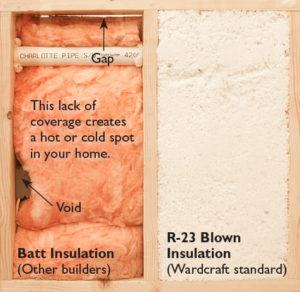
TECHNICAL STANDARDS
High Efficiency, Sealed Combustion HVAC & Hot Water Heater & Eco Performance Faucets
BENEFIT: As much as half of the energy used in your home goes to heating and cooling. High efficiency, sealed combustion HVAC equipment and water heaters with a sealed combustion chamber eliminate carbon monoxide fumes and creates a more comfortable home while using less energy. Eco performance faucets conserve water.
Standard 93%+ Furnace and 14 SEER A/C Equipment We use specialized software to design your duct system, ensuring proper sizing to maximize efficiency. This software takes into account the size and layout of the home, room sizes, window-to-wall ratio, insulation, windows and orientation of your home on the building site. Durable galvanized ductwork is standard for both supply and return air.
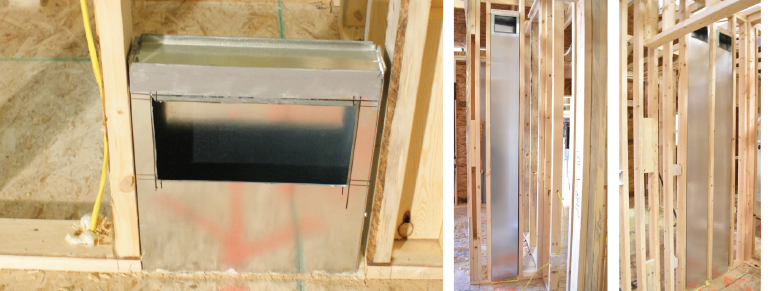 Galvanized supply and return ductwork is standard.
Galvanized supply and return ductwork is standard.
Standard Water Heater and Water-Saving Faucets
A high-efficiency 50 gallon water heater is standard and comes with an insulation blanket that helps retain more heat in the tank. Eco performance lavatory faucets are standard (these use 32% less water), with eco performance showerheads available at no additional charge.
Electrical & 12 Gauge Wire
BENEFIT: A heavier gauge wire will take more amperage.
Standard 12-gauge wire throughout. 200-amp electrical panel ,12-gauge wire and tamper resistant outlets throughout. Most builders use 14 gauge (except kitchen).
Energy-Efficient Pella® Encompass® Vinyl Windows
BENEFIT: High quality windows with Low-E glazing and improved thermal performance helps retain heat during the winter, retain cool air during the summer and block damaging UV rays.

Standard Pella Encompass Single-Hung Windows
We carry a full line of Pella vinyl, fiberglass and wood-clad windows for a beautiful wood interior.

Standard Passive Radon Standpipe
The majority of homes we build are located in areas with moderate to high levels of radon. Radon is the No. 2 cause of lung cancer in the U.S. Wardcraft installs a passive radon standpipe standard on every home (many areas do not require radon venting by code). Passive radon venting must have on-site portions & connections completed by your builder or radon specialist, including the foundation and roof venting requirements. If radon venting is needed, the standpipe is prepped for radon mitigation to be completed on-site. If further venting is required due to high levels of radon, an additional exhaust fan may be installed on-site by a radon mitigation specialist. The EPA recommends that all homes
in Zone 1 areas have radon reduction systems.

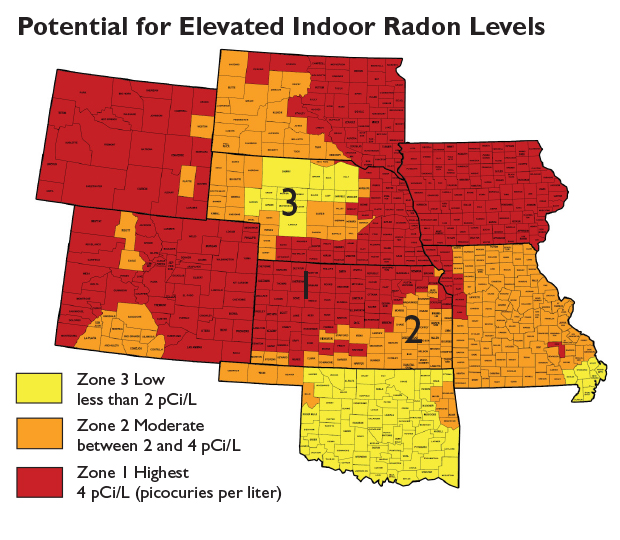
Building Thermal Envelope Testing
This test is designed to gauge the air sealing quality of your home and is performed on-site after the home is set on the foundation. This test is a customer’s responsibility if required by their local building authority. Ask your local authorized Wardcraft building professional to coordinate this option at an additional charge.
U.S. Climate Zones
The climate in which your new home will be built is an important factor in deciding how your new home should be built. The harsher climates that we build in demand a tighter building envelope and higher insulation levels to ensure every dollar spent heating or cooling your home is used as efficiently as possible. It is also important to include windows, doors or skylights that are suited to the home’s climate. Although many areas have strict building codes, others have virtually unrestricted building codes. For example, approximately 50% of Kansas has no building code. This means local builders can build very cheaply with subpar building materials and virtually no oversight. Choosing Wardcraft ensures stringent oversight and quality building materials in every state in which we build.
2012 International Energy Conservation Code (IECC) Energy Requirements.
This also meets or exceeds the 2015 IRC.
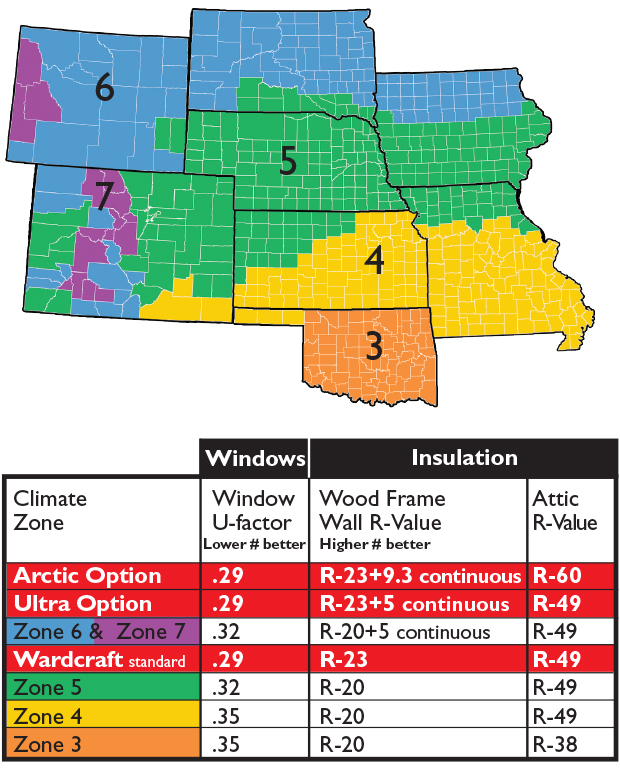
Windows: The lower the U-factor, the less heat is transferred, and the more energy-efficient the window.
Insulation: The higher the R-value the more energy-efficient the structure.
While some areas in the harsher climate zones have adopted the more strict 2012 IECC code, many conform to older codes. The International Code Council publishes codes on a three year basis. A new edition was published in 2015, however most jurisdictions have not adopted it yet.